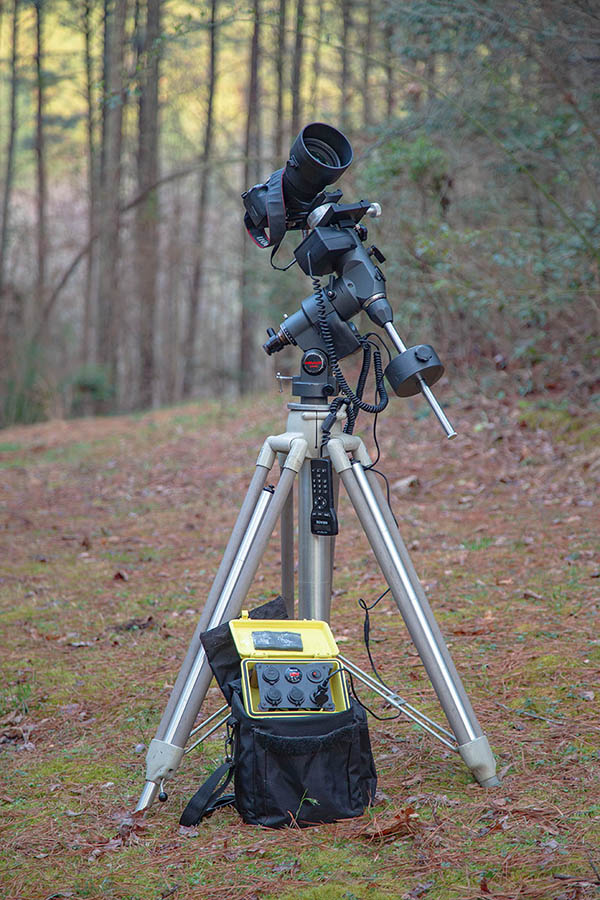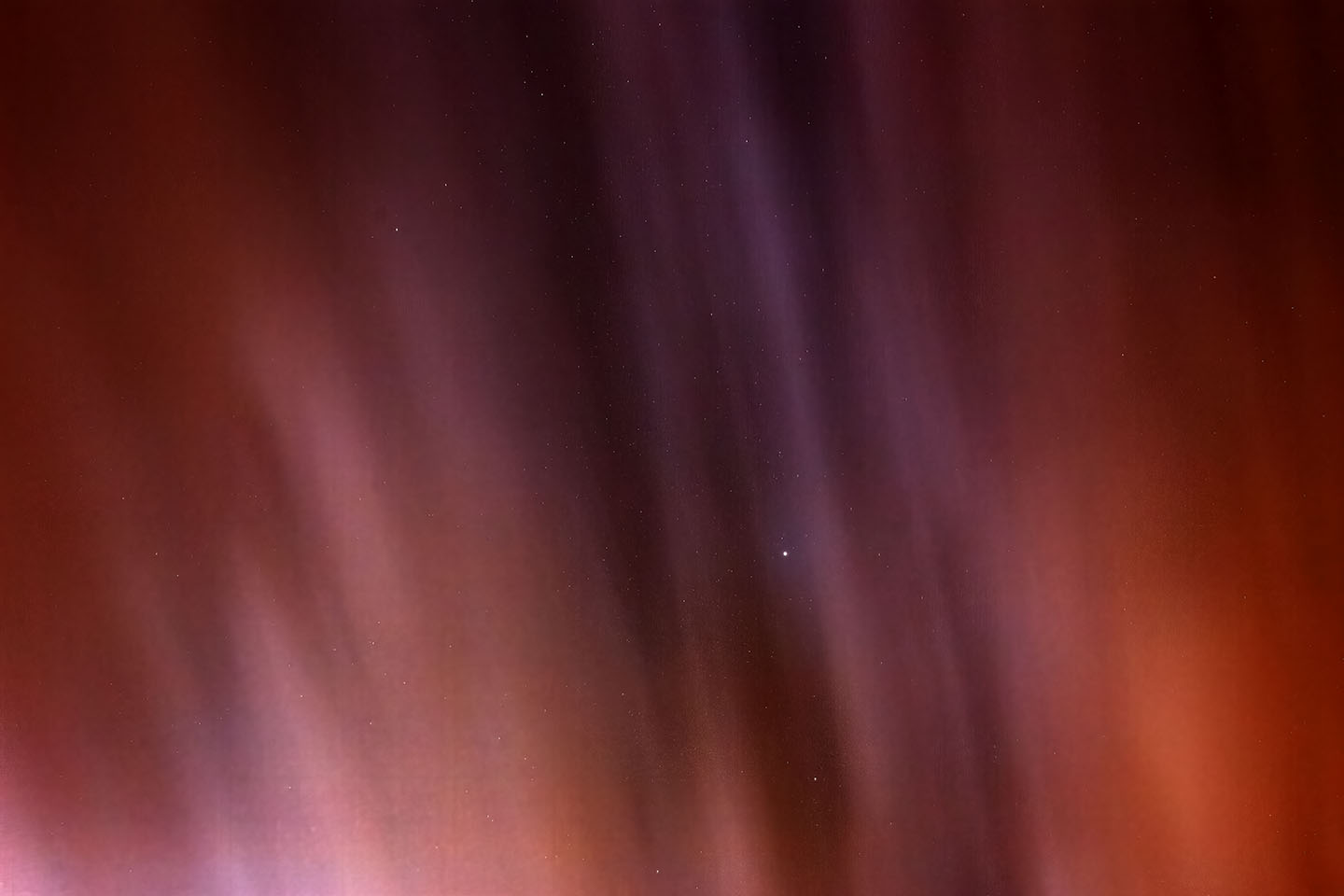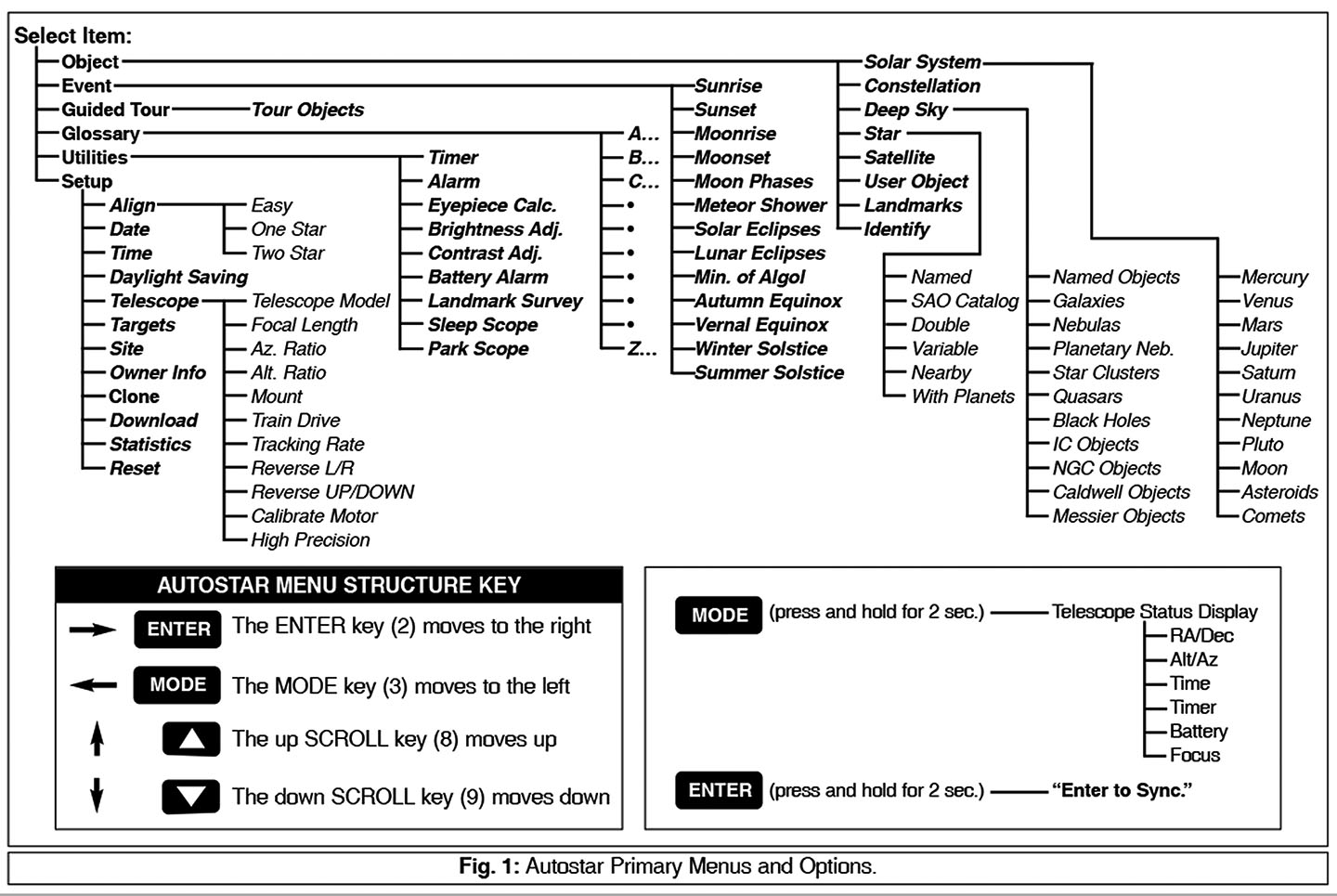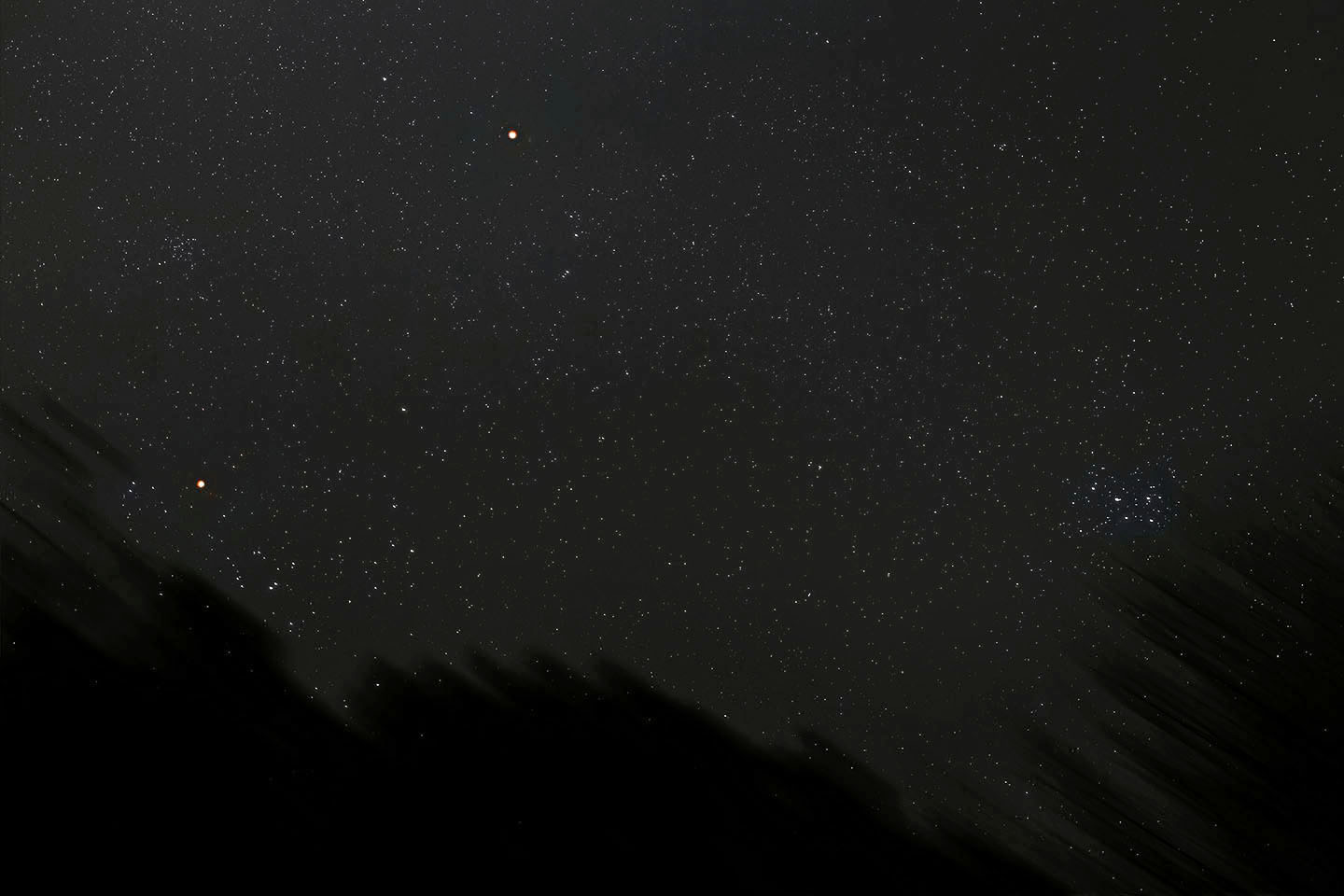The Bench-warmer.
2021/03/16. There's this LXD-55 Mount that's been gathering dust for years (10?). I originally bought it as a factory refurb as part of a misbegotten semi-plan to put its motors and electronics on a G11 but came to my senses before actually doing anything about that. I used it a couple of times as a portable mount to hold a solar telescope, but mostly it played third or fourth equatorial behind an A-P Mach1 and a Losmandy G11 (and truth be told, behind the original iOptron SkyTracker which lacks capacity but is otherwise just fine and handy).
Oh, Lord, it's another wordy "Slowblog" page. Just skip to the picture down below if you'd rather. Otherwise...
A Linhof Pro tripod turned up on AstroMart for $150, shipping included. The seller had three, and this one was described as "a beater," but it looked like everything I needed was in pretty good shape. So it was. It's really quite solid and smooth. It's no collectible, but it'll be beautiful in the dark. Maybe I'll turn some custom feet for it as I have done for other Linhofs, but that's not really necessary.
The G11 holds down an RV in New Mexico. The A-P mostly lives on the porch now that the trees have overgrown the backyard (and I've had a taste of Paris in the desert). The SkyTracker gets used as the portable mount for widefield messing about.
Here's what's changed since these roles became entrenched: I've added some fast glass to the kit, and digital cameras' useful ISOs have gone through the roof. It would be nice to put the LXD-55 back into service for the short sub-exposures that suffice with the Canon 6D, a future R6, and the ASI1600MM and so avoid having to horse the Mach1 in and out of the car, endangering both it and my back. As for glass, I am thinking mostly of the 105mm F1.4 Sigma, a bowling ball of a lens that is sharp and fast (but is fiercely attracted to the Earth). The mount ought to work well also with the TMB92, which can collect useful signal in short sub exposures and is short enough (especially at an EFL of 402mm) not to need guiding. It should be OK even on a (how to say this?) low-rent bargain-basement equatorial grinder like the LXD-55. A lot of people autoguide this mount, and a lot of people suffer while getting it sorted out; if I want guided astrophotos, I have easier, better options.
So. Arca clamp on a Losmandy-D plate cobbled up downstairs (table saw and lathe work omitted so as not to alarm the faint of heart), and fresh bolts from ScopeStuff to hold the counterweights in place (the originals have been knocked around doing duty on the Giro AltAz shooting moonrise video; lock bolts and even the counterweights are strictly optional in that role). One counterweight ought to do, but I've fixed them all up anyway (who knows?). Besides, after shipping, three bolts cost only a little more than one. After the mechanical bits, it ought to be just a matter of getting juice to the motors and telling the electronics to not do anything but spin the RA motor.
2016/03/18. The damn thing appears to be possessed. Turn it on and the Autostar 497 controller insists on going full-on Linda Blair spinning the mount around in unexpected and unhealthy directions. It's telling me it wants to be initialized and aligned. But I don't care if the mount knows which way is up, what it's carrying, what time it is, where it is, or what's above the horizon. I'll aim the polar axle at the north celestial pole, and I'll take it from there, thanks. I expect the RA motor to turn the mount once per day. The end. [See the Menu Map down below. It works nicely.] Here's the kit during a lull in today's rain:

On the ground is a new, old-stock Kendrick bag I've filled with a deep-cycle AGM battery (about 35AH), feeding 12v and USB ports in a power distribution panel intended for a bass- or houseboat but stuck in a tiny Pelican case instead.
I can pick everything in the picture up and carry it from place to place in one trip. I'm not saying it's fun, but it can be done. One more part is on the way: a 90-degree 2.1mm plug to carry power to the mount. Ordinary straight ones stick out from the controller so far that an errant dec motor can take it and the electronics its connected to right out of the mount. Bad Meade, bad, bad Meade. [Arrived. Not sure it's an adequate fix, but WTH, let's use it for now.]
Star trials (not trails, one hopes) when the sky clears and the Moon grows small.
2021/03/20. The Aurora Carolinas: moonlight and light pollution in the northern sky, with a scattering of stars in the constellation Auriga. Clear skies all day were forecast to stay that way until about 10:30PM, but did they? Of course not. Shelves of clouds slid in just after sunset.

I stubborned up and tested the LXD55 mount with a short telephoto anyway. I could *just* glimpse one bright star north of the Moon (Capella?) from time to time, so I tried three, 30-second exposures (105mm, F5.6, ISO 400). The stars didn't perfectly line up, but then I was ridiculously casual about polar alignment (I just sort of pointed the polar axis in the right general direction). The individual frames are nice and tight. It's a very forgiving outfit, and this combination is clearly going to work. Above are all three frames aligned and averaged just for kicks -- a few reassuring stars in a field of blowing, underlit clouds. "View Image" for a closer look and a lot more stars. This is a proof of concept in case the sky is ever clear and dark. Maybe I should find a right-sized Bahtinov mask (of course I should; one is on the way) because focus will be difficult and important behind a sharp F1.4 lens. I focused on the Moon tonight and basically got lucky.
The Menu Map for Autostar from page 5 of Meade's manual worked well to brighten my displays and otherwise define a working configuration. The key is to hit MODE the "5" key to escape the warning about looking at the Sun and then press MODE to accept date, time, Standard/Daylight time, etc. After that, you come to Setup / Align / Easy and the RA motor is running and the slewing buttons are live. Note that I'm running Autostar v33 but 42eg seems to be the gold standard. Anyway, here. Good luck:

Click the preview for a more legible view, big enough to print.
2021/03/21. The picture is no great shakes (Mars in Taurus -- Mars is at top -- Aldebaran at left, the Pleiades at right), but it's not awful considering there was a bright quarter moon just out of the frame to the left. I think we finally have an outfit that's VERY EASY to throw in the car to go someplace dark and also WORTH throwing in the car to go someplace dark. Those two virtues have never been particularly easy to combine.

105mm Sigma, 12x30s, ISO 800, Canon 6D, casually aligned LXD-55
Click the pic to admire it properly.
Yes, I do know that no one buys a 105mm F1.4 Sigma to shoot it at F5.6. You think I don't know that? I did mention the bright Moon, though, right, and I would point out the aim is to try out this newly resurrected mount. For that, 5s at F1.4 is no test at all.
Easy sidereal tracking with the LXD-55 & Autostar:
Power on. Hit MODE (which is also "enter") to get past the do not look at the sun warning, accept the date, time, and time zone, and on the next press, voila! The motor starts, the screen says "Align Easy," and you're in business.
By the way: the iPhone compass app and a roof level app are enough to get polar alignments that are easily good enough for the 105mm and 30s exposures with the 6D.
My deep-sky photos are made with a variety of sensors and optics. Deepest images come now from a ZWO ASI1600MM Cooled Pro CMOS camera. A good many images come from an unmodded Canon 6D. Video and video extracts begin in a Canon EOS M, usually running in crop mode via Magic Lantern firmware. Telescopes include an AT10RC (a remarkable budget Ritchey-Chretien astrograph), an Orion 10" F4 Newtonian, and a pair of apochromats: a TMB92SS and a AT65EDQ. A very early Astro-Physics 5" F6 gets some use, too. So do lots of camera lenses on both the ASI1600 and the Canon 6D. A solar Frankenscope made using a 4" F10 Orion achromat and the etalon, relay optics, and focuser from a Lunt 60 feeding a small ZWO camera will see more action as the Sun comes back to life. Mounts include an iOpton SkyTracker (original model), a Losmandy G11 (non-Gemino), and an Astro-Physics Mach1 CP3. Software is PixInsight for heavy lifting and Photoshop for polish.
:: top ::